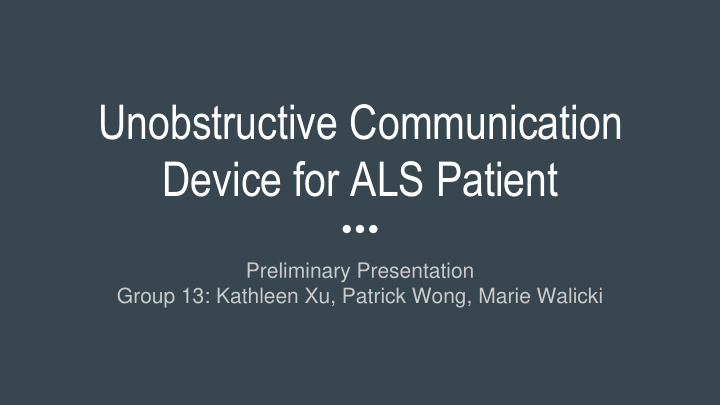



Unobstructive Communication Device for ALS Patient Preliminary Presentation Group 13: Kathleen Xu, Patrick Wong, Marie Walicki
Background • Amyotrophic Lateral Sclerosis (Lou Gehrig’s Disease) • Neurodegenerative disease that causes muscle weakness, paralysis, and respiratory failure • Affects more than 450,000 people • No cure currently • Medications like Riluzole can reduce damage to motor neurons and muscle fatigue • Stephen Hawking
Problem • 19 year old girl with ALS • Nonverbal • Uses an eye-gaze device that tracks her eye movements on her monitor • Synthesizes speech based on buttons • Monitor is mounted on the patient’s wheelchair via Mount’n Mover • Monitor currently cannot be used outside of wheelchair • Limited access to communication
Need Statement A way for an ALS patient to effectively communicate with their alternative speech devices outside of their wheelchair to optimize their access to communication
Project Scope • Goal: Help the patient to communicate effectively outside of her wheelchair. • Deliverables: Physical prototype, a CAD drawing of the device, and reports of the development process. • The project will be completed when a prototype is produced with device specifications that can be replicated, by April 17, 2017. • Costs: $300 or less
Specific Design Requirements • Design an extension to the patient’s system rather than a whole new system • Mount the patient’s communication monitor within their range of vision while the patient is outside her wheelchair • Weight of device: less than 5 kg • Weight device can support: at least 5 kg • Rotational Range: at least 180 degrees in sagittal plane & 360 degrees in transverse plane • Dimensions of connection to monitor: 7 cm x 15 cm x 2 cm • Cost: $300
Existing Solutions: Mount’n Mover • Patient currently uses Mount’n Mover which is patented by Blue Sky Designs • Attaches on the wheelchair • Adjusts the speech device to the optimal angle for patients • Cost: ~$800 - $1200 • Limitations: Does not rotate to the appropriate eye plane level for a patient not sitting upright
Existing Solutions: Brain Computer Interfaces (BCI) • Control electronic devices by reading electric signals in brain • Brain signal acquisition • Feature filter and extraction • Translation algorithm • Output device commands • Invasive (bottom) and non-invasive (top) depending on severity • Limitations: speed of communication, availability and cost ($5000-$10,000 for non-invasive)
Existing Solutions: HeadMouse Nano • Augmentative communication method that replaces standard computer mouse • Designed for people who cannot use their hands • Wireless optical sensor tracks head movements to determine mouse movements • Can be used on speech-generating devices • Cost: ~$1000 • Limitations: our patient does not have the ability to fully control her head movements
Existing Solutions: The Computer • Stephen Hawking’s computer system • Assistive Context-Aware Toolkit (ACAT): word prediction algorithm • Speech Plus: speech synthesis • Cursor scans across soft keyboard • Uses cheek movements detected by his spectacles to stop cursor • Limitations: resources are not feasible for our patient
Preliminary Design Schedule
Division of Responsibilities • Marie Walicki: device modeling and professional contact • Patrick Wong: literature research, CAD models, and report compositions • Kathleen Xu: client contact, prototype design, and webpage management
Questions?
Recommend
More recommend